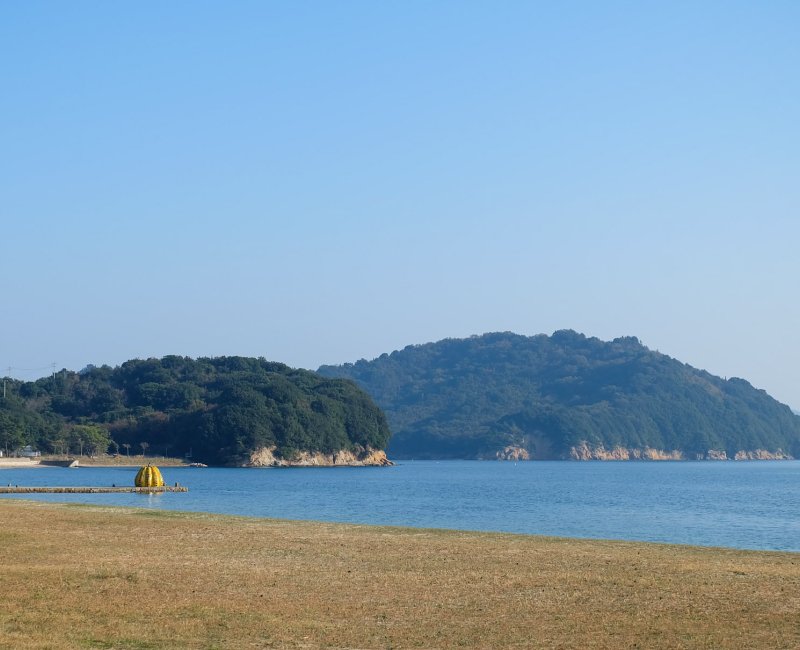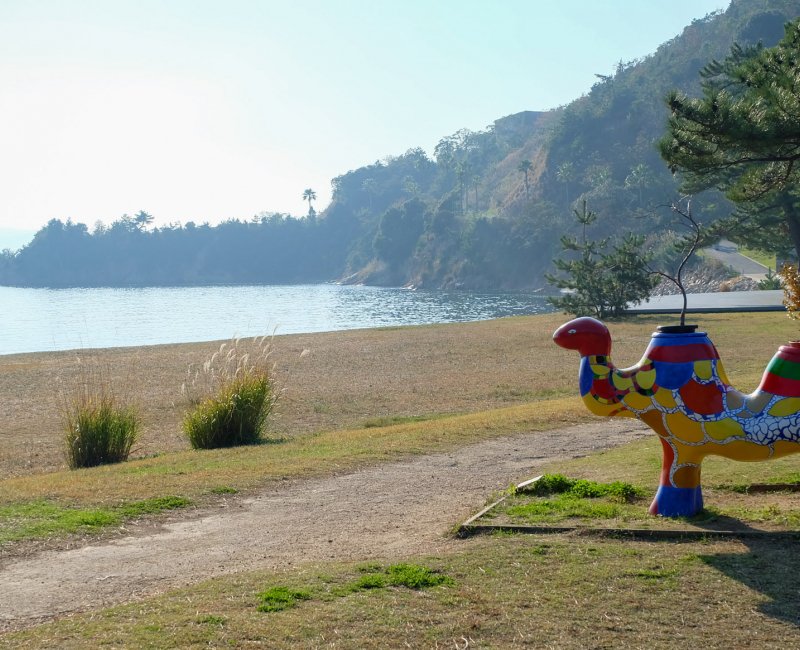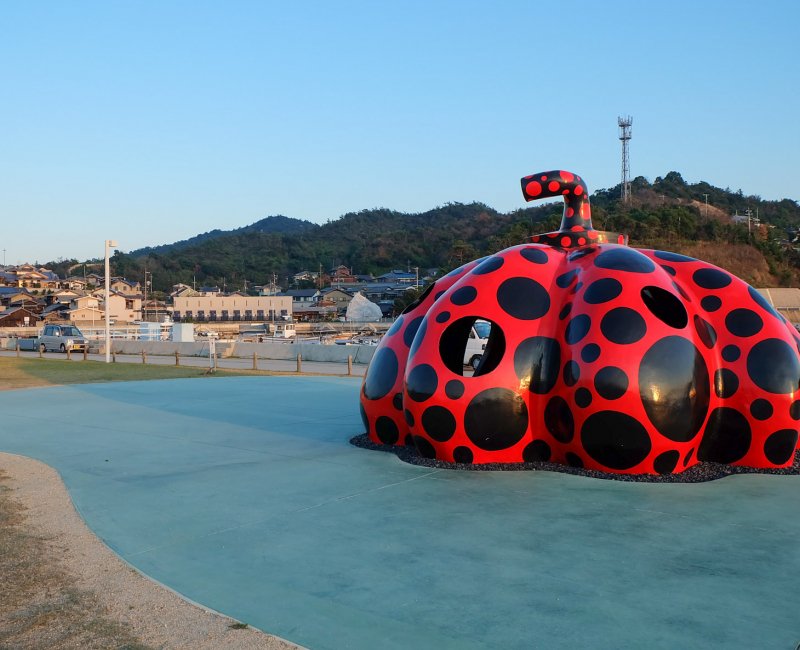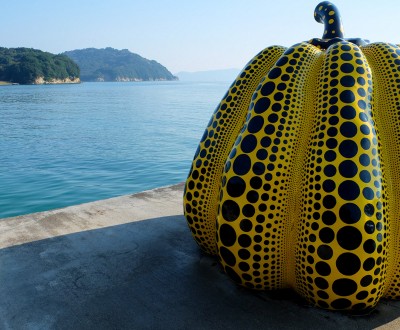Naoshima
The Most Famous Artistic Island on the Seto Inland Sea
Naoshima is a small Japanese island located in the Seto Inland Sea and attached to Shikoku's Kagawa prefecture. Its modern art museums, its architectural buildings and sculptures scattered all around its landscapes earned it worldwide fame.
Naoshima benefits from a pleasant climate ideal to enjoy the wonderful sceneries of the Seto Inland Sea, as well as its sand beaches 🏖 in summer. The incredible views unfold as soon as boarding the ferry ⛴️ connecting Honshu to Shikoku, as a prelude to the contemporary art exhibitions on the island.

In the 1980s, Soichiro Fukutake, then chairman of the Benesse Corporation (a big company based in Okayama), decided to create an Art capital on Naoshima, an island that was mainly an industrial site operated by the Mitsubishi Group at the time. With the help of famous architect Tadao Ando, he founded several museums and all the buildings of the vast "Benesse Art Site Naoshima." The town’s facilities and schools were designed by architect Kazuhiro Ishii.
Benesse House Museum
The Benesse House standing on the end of the southern side of Naoshima is an unmissable location on the island, for several reasons:
- Its abstract architecture, in a display of huge volumes and concrete walls.
- The artworks it houses are very interesting and diverse (pictures are prohibited so you'll have to go see for yourself).
- The free surroundings of the main building, including its park and close to the beach, are decorated with numerous sculptures, such as Niki de Saint Phalle’s colorful installations or Yayoi Kusama's famous yellow pumpkin (Kabocha), the unofficial symbol of Naoshima (it was restored on October 04, 2022).
- The famous art museum surprisingly offers about forty hotel 🏨 rooms in addition to the artworks display.
The museum’s building is placed at the top of a cliff and we recommend stopping by Issen, a cafe-restaurant offering a diving view on the Seto Inland Sea. The souvenir shop has a good supply and amateurs of Tadao Ando’s architecture will likely quench their thirst for design.

Chichu Art Museum
This marvelous artistic location is almost completely buried into the ground, and while its admission fee can be expensive, it is certainly worth the visit. The museum’s architecture, also designed by Tadao Ando, and the Monet exhibition it is sheltering are equally interesting.
The natural light varies throughout the day and the facility, providing a timeless and contemplative atmosphere. Note that quietness is expected from visitors, so you may want to avoid going with very young children. Ticket online reservation is advised and available up to 2 months in advance (tickets on sale each month from the 10th).
Lee Ufan Museum
This museum is mainly recommended for its outdoor installations, that are free and provide a beautiful view on the coastline. The permanent collection is more suited to architecture aficionados and may seem a bit too light for the others.
Art House Project
Striding away from the quiet artistic shores of the island’s southern coast, Honmura Port offers a livelier village. It is where the Art House Project is laid out, aiming at an artistic upgrading of several old houses:
- Kinza, a house that is to be visited alone and upon reservation only. With solitude as a companion, sit on a wooden bench to admire the artwork of Japanese artist Rei Naito who restored the house;
- Haisha used to be a dentist office before being converted into a beautiful and original artsy house;
- Minamidera offers a sensory experience designed by artist James Turrell, with a staging involving dark spaces and several illuminated screens. The building is new and was designed by Tadao Ando;
- The first house of the project, Kadoya, is still offering and interesting LED light up of numbers around a pond;
- Go’o Shrine is a quirky installation with a glass stairway going down a narrow passage enclosed by 20 meters high concrete walls, not for the claustrophobic;
- Gokaisho is the least interesting. Dwelling on the camellia flower and the passing of seasons, it is based on the opposition of right and wrong;
- and a little bit remote from the other houses, Ishibashi is the former house of a local family working in the salt-making industry. The fusuma sliding doors are beautifully lit up depending on the season.
Still near Honmura Port, the Ando Museum is also established in a minka traditional house, that was completely redesigned in the style of the modern Japanese architect.
To end the day of strolling on a high note and before boarding the boat for the return trip, the sento public bath called I Love Yu (I♥︎湯) welcomes everyone (including tattooed visitors) in its comfortably warm water (between 39 and 40°C / 102-104°F) in a beautiful decor. It is located across Miyanoura port, where is displayed Yayoi Kusama’s red pumpkin.

Pacing the island’s visit to the exhibitions
Naoshima changes day to day and according to the time of the year. Most of its museums are indeed closed on Monday (except for the Benesse House), so the average frequentation on this particular day drops by 90%! Whereas on the other days, visitors come in numbers to walk on the tiny roads from one artwork to another.
The Setouchi Triennale is the highlight of Naoshima and its neighboring sister islands that also host the event. This international art fair has been taking place every 3 years since 2010, over 3 periods of temporary exhibitions: in spring 🌸, in summer and in autumn 🍁. In 2019, for the 4th Setouchi Triennale, Naoshima received one million visitors. As a comparison, the population in Naoshima town (that includes several islands) is slightly above 3,000 inhabitants, according to the last population survey in 2020, and has been slowly declining over the years.
With an 8km² superficies, the island stays within a human-sized grasp, but we recommend renting an electric bicycle to move around more easily and better enjoy the many art clusters scattered throughout the southern side of Naoshima Island.

